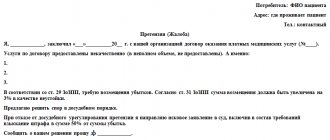Every tenant or homeowner must pay for housing and communal services. This process is performed on the basis of receipts that are sent by the management company to the payer’s address. The documentation is equipped with calculations, necessary information and even a barcode, which greatly simplifies the process of depositing funds.
Dear readers!
Our articles talk about typical ways to resolve legal issues, but each case is unique. If you want to find out how to solve your particular problem, please use the online consultant form on the right or call.
It's fast and free! At the same time, there are certain requirements regarding how long the receipts must be kept.
Payment Methods
The consumer has the right to pay bills in a convenient way:
- cash at the cash desk;
- to the bank in cash according to a receipt, non-cash from an account - card, personal;
- using online services and payment systems.
Regardless of the application method, there are general recommendations:
- Make sure that the details of the payer and recipient are indicated correctly (pay special attention to the payer’s personal account number, his last name, first name, patronymic, address).
- Check the deposited/transferred amount.
- Receive a proof of payment - a check, a receipt, an electronic check.
If it is absent, make sure that the money for the consumed resource has been received by the supplier (the invoice includes lines about the debt at the beginning of the period and the amounts paid, after which the total amount payable is reflected, taking into account payments).
What is reflected in receipts for housing and communal services
A receipt for payment of housing and communal services is a document drawn up according to the model approved by Order of the Ministry of Construction and Housing and Communal Services of the Russian Federation 43/pr dated January 26, 2018.
A receipt for payment of utilities is an official payment document confirming the presence or absence of debt to management or resource companies for past periods
The receipt form is optional. For the convenience of payment and accounting of payments in different regions, it may differ, but the required details remain:
This is important to know: Statement of claim for violations in housing and communal services
In the updated form, the section on major repairs has been removed, which will now be paid for on a separate receipt.
Video: what does a receipt for housing and communal services consist of?
Shelf life
How long payment papers are kept depends on the status of the payer - it is an enterprise or a citizen.
For legal entities
Methodological recommendations for organizations have been developed, based on the requirements of the law of October 22, 2004 N 125-FZ “On archiving in the Russian Federation”[2]. They indicate that documents relating to settlements with suppliers are stored for 5 years.
This is due to the fact that the Federal Tax Service and other regulatory organizations can check documents for the previous three years, and more if necessary (for example, if the check started earlier and the deadlines were extended), and both parties can check - the payer, the management company, and verify their data in within the framework of counter checks. But this applies to companies.
For individuals
There is no law obliging citizens to keep checks and other documents confirming payments for a certain number of years. There are also no regulatory requirements for citizens regarding storage periods.
To collect debts from management companies, homeowners' associations, and resource supply organizations, a general statute of limitations is applied - 3 years from the date of failure to fulfill the obligation to pay the amounts due (Articles 196, 200 of the Civil Code[3]). Of course, extra papers create certain inconveniences, but it is still better to store them.
Receipt for payment of utilities
We are used to living in rooms with all the amenities. Light, heat, water and gas in the house are taken for granted as conditions of modern life. The corresponding utility and housing companies are responsible for providing these amenities to the country's citizens.
These services are not provided free of charge, all require monthly payment. To ensure that there is as little paperwork as possible, all data is consolidated into one utility bill receipt. Recently, the type of receipt has changed a little.
Receipt for payment of utilities: type and contents.
The information contained in the receipt for payment for services differs only depending on the type of housing. The services provided by public utilities in the private sector and in apartment buildings have certain differences. Thus, in receipts in the private sector you will not find information about payments for cleaning entrances or paying for intercoms. And in apartments in the summer there is no additional payment for watering.
This is interesting: I lost my passport, how to recover it 2021
Error in housing and communal services receipt: recalculation of utility fees.
What is included in the maintenance and repair of housing in the receipt from 2021, read here.
The receipt contains the following information:
- personal account of the home owner;
- the period for which payment is made;
- personal data of the payer;
- what kind of real estate is being paid for;
- type of ownership of this property;
- total area of housing, how many people are registered;
- information about the company that provides services;
- what utilities are paid by the payer with this receipt;
- what is the scope of services;
- the size of the resource allocated to the entire house;
- data on the volume of a specific service provided;
- meter readings: previous and current, established tariff, how much needs to be paid in the end, data on outstanding payments, final result;
- services with recalculation, if necessary;
- what payment benefits does the payer have, the availability of the subsidy provided;
- agreement on deferred payment or payment in installments.
What are the features of a receipt for payment for housing and communal services?
Modern receipts for payment of housing and communal services are quite easy to use. You can easily figure out how much and what we pay for.
If there are differences in forms for paying utility bills, they mainly depend on the company that provides the services. In general, the forms have mandatory clauses. The top line contains information about the month and year for which payment is made.
Most often, payment is made in two ways:
- for services provided in the current month;
- for services provided in the previous month.
For which month the services will be paid depends on the agreement between the consumer of the services and the company providing these services. If you have a meter for electricity, gas or water, payment is made according to the readings that are displayed on the meter at the moment.

Not all services are recorded by meter readings. Some services have fixed rates. The amount of payment depends on the number of residents registered in a particular residential premises.
When concluding contracts for the provision of various services, the owner must provide accurate data on the total area of the housing, since it is they that affect the amount of payment for certain services. If the data is inaccurate, the final payment result will also be incorrect, which will lead to debt or the need for recalculation.
The water supply service can be calculated based on the meter readings, and if there is no meter, the amount is calculated based on the number of persons living in a given area. Each form must indicate the number of people registered in the premises.
If one of the residents is absent for a long time, a recalculation of the water consumed is carried out. But the fact of absence will need to be confirmed with certain documents.
Reasons for storage
Over time, management companies change, homeowners associations are created and dissolved, and the transfer of balances from one organization to another is not always correct. Supporting documents will help you prove that there is no debt and everything has been paid. Sometimes the organization’s system itself distributes payments incorrectly to payers - the amounts are lost. There may be software glitches. Errors cannot be ruled out when transferring funds by banks.
In case of disputes, payment documents serve as proof of the deposit of funds by consumers into the account of the management company. For legal proceedings, the fact of payment is important - according to the law, the consumer is obliged to prove payment, and without the appropriate document it will not be possible to justify himself.
Types of services indicated on receipts

The form of issue of this payment document is approved by law. The receipts indicate all the resources provided. Each resource is highlighted on a separate line:
- electricity;
- gas;
- cold and hot water;
- heating;
- other types of services (elevator, intercom, territory cleaning, repairs).
The resource standards calculated for one consumer are also indicated. They are established by regional authorities.
Each payer has a personal code in the form of a set of numbers. This is convenient for making payments through bank terminals.
This is interesting: How to marry a foreigner in Russia
How to optimize
For those who prefer to reduce storage volume, we can advise using modern methods - for example, saving electronic copies of receipts and receipts. You can obtain information through the history of payments in the bank, if the money was transferred through an account or using a card.
By the way, checks and ATM receipts often fade, sometimes in a very short period of time - therefore, if you store a paper document, it is recommended to make a photocopy of the original document.
There is a more reliable way - to regularly reconcile payments and accrued amounts with the management and resource supply organization, as a result of which it is imperative to receive a reconciliation report drawn up in accordance with all the rules. Such a document must be signed by an authorized representative (it is better if the manager does this, since the representative will also be required to have a power of attorney for the appropriate authority).
After full payment and completion of all checks, take a certificate of no debt on a certain date. Such a certificate also serves as evidence in court proceedings.
Until a period has been established at the legislative level during which consumers are required to keep all receipts for payment of utility services, everyone decides for themselves how and for how long to store payment documents.
How mobile operators deceive us: 5 creepy and funny stories from life
In addition, if we determine storage periods based on the statute of limitations, then we must know something else. If the statute of limitations expires, you can still claim protection for the violated rights. Therefore, saved receipts can not only come in handy, but also become a trump card up your sleeve.
- Not a single regulatory act specifically specifies how many years it is necessary to keep receipts with a mark or check for payment of housing and communal services, so the law on the statute of limitations for claims comes into play. According to it, the statute of limitations for disputes of this kind expires 3 years from the moment the problem situation arises.
- This law is not an obstacle to the court accepting a claim, but if this point is voiced in court, the decision in 100% of cases will be made in favor of the service consumer.
- It happens that management companies try to resort to various kinds of tricks, trying to forcefully extend the statute of limitations. This happens extremely rarely, only in the event of real force majeure circumstances. For example, the entire management company was on a desert island for three years and did not have the opportunity to go to court to collect the debt for housing and communal services.
To ensure the safety of invoices for payment of services, it is recommended to store them in a separate folder. This will allow you to find documents when problem situations arise as quickly as possible.
Due to the lack of properly organized work of departments in public utilities, bills are issued to bona fide payers.
The receipt may contain many numbers, but do not be alarmed. After all, these are instrument readings for previous periods. Regional authorities establish certain standards, indicating what exactly should be written down on the receipt. That is, these are not only current amounts, but also those that have already been issued previously.
If a consumer pays for utilities via the Internet (for example, Sberbank Online), it is enough to save and print the receipt, then attach it to the payment receipt sent monthly for entering readings and payment. Calculation using the terminal. In this case, you will need to have a payment card available, which must be placed in a special slot. After this, you will need to enter data into the electronic form that appears - code, information about your account, payment amount. Then you need to confirm the transaction and receive a confirmation receipt.
The information is presented in the form of a clear and simple table, so everyone can easily understand all the information.
Difficulties with debts arise in relations with all organizations in the housing and communal services sector. We are talking about a management company or HOA, companies involved in water supply, electricity supply and gas supply.
Payment of utility bills can be done in several ways. The most common of them is depositing cash into the company’s account through a cash desk or terminal of one of the banks. Payment through online accounts, that is, electronically, is gaining popularity.
Payment for utility services is carried out on the basis of a receipt provided by the contractor. Such information must be transferred to payers within the period established by law. According to the general rules, a receipt for payment is given no later than the first day of the month following the reporting month.
This is important to know: Application to housing and communal services for recalculation of utility bills: sample
Storing payment documents becomes difficult due to the space they take up. But how long are utility bills kept? And what's the point of doing this?
In most cases, the receipt itself is sent by mail. The information is also duplicated on the information resources of the management company. At the same time, the law does not prohibit personal delivery of a document to the payer. This method is mainly used in cases where there is arrears in payment.
In cases where filing a claim was impossible due to certain circumstances that did not depend on the actions and desires of the plaintiff (for example, emergency situations: flood, earthquake, military operations, epidemics, etc.) After the termination of these circumstances, the limitation period continues to run.






